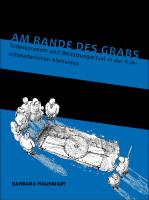Am Rande des Grabs
Todeskonzepte und Bestattungsritual in der frühmittelalterlichen Alamannia
Abstract
The original circumstances in which archaeological remains came into being are crucial for the interpretation of the material record. Burials are first and foremost a result of a very traumatic event in a society – the death of one of its members. It is due to this context that burials represent a primary source for understanding past societies’ attitudes towards death. Barbara Hausmair traces death concepts and their influence on mortuary rituals in early medieval communities in what is today known as southwest Germany. Using the cemeteries of Bad Mingolsheim, Horb-Altheim and Weingarten as case studies, the author compares archaeological patterns based on grave goods and grave arrangements with anthropological data on age, sex, pathologies, trauma and migration patterns of the deceased. By connecting the observed patterns with social theories on human death behaviour, Hausmair dissects the complex network of the burial communities’ social structures, death concepts and the newly constructed identities of the dead in the afterlife. Her thanatological approach provides original insights into the relationships between burial practices and ideas about death in Merovingian-period Alamannia by sensibly combining theoretical considerations with a thorough analysis of archaeological material. Alle Kulturen lösen dieses Urproblem [den Tod] der menschlichen Existenz auf ihre Weise, und es gibt gewiß keine Kultur, die sich nicht als Lösung dieses Problems verstehen und auf diese Kernfrage hin analysieren ließe. (Jan Assmann, Der Tod als Thema der Kulturtheorie) Der Entstehungskontext archäologischer Befunde und der darin fassbaren Objekte spielt eine bedeutende Rolle für die Interpretation materieller Hinterlassenschaften. Gräber sind in erster Linie das Resultat eines emotional und sozial prekären Ereignisses in einer Gesellschaft – dem Tod eines ihrer Mitglieder. So stellt das Grab auch aus archäologischer Sicht eine primäre Quelle für die Auseinandersetzung mit dem Todesverständnis in vergangenen Gesellschaften dar. Barbara Hausmair geht in ihrer Untersuchung dem Einfluss von Todeskonzepten auf die Bestattungspraktiken der Bevölkerung in der frühmittelalterlichen Alamannia nach. Am Beispiel der Gräberfelder Bad Mingolsheim, Horb-Altheim und Weingarten unternimmt sie einen Vergleich von archäologischen Mustern auf Basis der Grabbeigaben und Grabgestaltung mit anthropologischen Daten zu Alter, Geschlecht, Herkunft, Verwandtschaft und Gesundheitszustand der Bestatteten. Die durch diese Clusteranalysen eruierten Gruppen setzt sie in Beziehung zu soziologischen und kulturanthropologischen Theorien und Modellen zum Umgang mit dem Tod und zeichnet so das komplexe Zusammenspiel von Sozialstrukturen in den jeweiligen Bestattungsgemeinschaften, Todeskonzepten, Folgeweltmodellen und neu konstruierten Identitäten der Toten im Jenseits nach. Die thanatologische Herangehensweise bietet neue Einblicke in die Bestattungspraktiken und Vorstellungen merowingerzeitlicher Gemeinschaften in Südwestdeutschland und präsentiert eine sensible Verknüpfung theoretischer Überlegungen mit einer archäologischen Materialanalyse.
Keywords
funerary archaeology; death; middle ages; burial practicesPublisher
Sidestone PressPublisher website
https://www.sidestone.com/Publication date and place
Leiden, 2015Imprint
Sidestone Press DissertationsClassification
Archaeology by period / region
Europe
c 1000 CE to c 1500


 Download
Download Web Shop
Web Shop